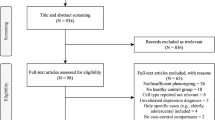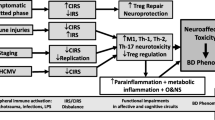Abstract
Previous studies of lymphocyte distribution in schizophrenia have yielded inconsistent results, as summarized in the present study. Based on our own original data, potential confounds that might explain these variations are analyzed and discussed. Blood samples from 26 patients with acute paranoid schizophrenia were investigated in comparison with 32 matched healthy controls by flow cytometry (CD3, CD4, CD8, CD19, and CD56 phenotyping). A subgroup of drug-free patients was followed up after 6 weeks of treatment. Cotinine levels and the free cortisol index (FCI) were provided in order to control for medication, smoking, and stress. Cotinine levels correlated with natural killer (NK) cell counts (CD3−/CD56+: r = −0.383, P = 0.003) while the FCI was related to B cell numbers (CD19+: r = 0.390, P = 0.003). Considering these covariates, a lower level of T helper cells (P = 0.010), a reduced CD4/CD8 ratio (P = 0.029), and elevated B cells (P = 0.008) were found during acute psychosis. After 6 weeks of medication, an inverse pattern was observed in initially drug-free patients: total T cell (P = 0.005), T helper (P = 0.003), and T suppressor/cytotoxic cells (P = 0.005) increased, while B cell counts declined (P = 0.049). In conclusion, acute paranoid schizophrenia may be accompanied by a reduced T cell defense and a shift towards B cell immunity, which normalizes in response to treatment. In addition to disease stage or subtype and medication, cigarette smoking and stress are important co-factors.

Similar content being viewed by others
References
APA (2000) Diagnostic and statistical manual of mental disorders, 4th revised edition (DSM-IV-TR). American Psychiatric Press, Washington
Baskak SC, Ozsan H, Baskak B, Devrimci Ozguven H, Kinikli G (2008) Peripheral blood T-lymphocyte and T-lymphocyte subset ratios before and after treatment in schizophrenia patients not taking antipsychotic medication. Turk Psikiyatri Derg 19:5–12
Bilici M, Tekelioglu Y, Efendioglu S, Ovali E, Ulgen M (2003) The influence of olanzapine on immune cells in patients with schizophrenia. Prog Neuropsychopharmacol Biol Psychiatry 27:483–485
Borda T, Perez Rivera R, Joensen L, Gomez RM, Sterin-Borda L (2002) Antibodies against cerebral M1 cholinergic muscarinic receptor from schizophrenic patients: molecular interaction. J Immunol 168:3667–3674
Bramer SL, Kallungal BA (2003) Clinical considerations in study designs that use cotinine as a biomarker. Biomarkers 8:187–203
Brisch R, Bernstein HG, Krell D, Stauch R, Trubner K, Dobrowolny H, Kropf S, Bielau H, Bogerts B (2007) Volumetric analysis of septal region in schizophrenia and affective disorder. Eur Arch Psychiatry Clin Neurosci 257:140–148
Brown AS, Begg MD, Gravenstein S, Schaefer CA, Wyatt RJ, Bresnahan M, Babulas VP, Susser ES (2004) Serologic evidence of prenatal influenza in the etiology of schizophrenia. Arch Gen Psychiatry 61:774–780
Cohen J (1992) A power primer. Psychol Bull 112:155–159
Coste J, Strauch G, Letrait M, Bertagna X (1994) Reliability of hormonal levels for assessing the hypothalamic–pituitary–adrenocortical system in clinical pharmacology. Br J Clin Pharmacol 38:474–479
Craddock RM, Lockstone HE, Rider DA, Wayland MT, Harris LJ, McKenna PJ, Bahn S (2007) Altered T-cell function in schizophrenia: a cellular model to investigate molecular disease mechanisms. PLoS ONE 2:e692
Drzyzga L, Obuchowicz E, Marcinowska A, Herman ZS (2006) Cytokines in schizophrenia and the effects of antipsychotic drugs. Brain Behav Immun 20:532–545
Eaton WW, Byrne M, Ewald H, Mors O, Chen CY, Agerbo E, Mortensen PB (2006) Association of schizophrenia and autoimmune diseases: linkage of Danish national registers. Am J Psychiatry 163:521–528
Frazer-Abel AA, Baksh S, Fosmire SP, Willis D, Pierce AM, Meylemans H, Linthicum DS, Burakoff SJ, Coons T, Bellgrau D, Modiano JF (2004) Nicotine activates nuclear factor of activated T cells c2 (NFATc2) and prevents cell cycle entry in T cells. J Pharmacol Exp Ther 311:758–769
Ganguli R, Rabin BS (1993) CD5 positive B lymphocytes in schizophrenia: no alteration in numbers or percentage as compared with control subjects. Psychiatry Res 48:69–78
Geng Y, Savage SM, Johnson LJ, Seagrave J, Sopori ML (1995) Effects of nicotine on the immune response. I. Chronic exposure to nicotine impairs antigen receptor-mediated signal transduction in lymphocytes. Toxicol Appl Pharmacol 135:268–278
Geng Y, Savage SM, Razani-Boroujerdi S, Sopori ML (1996) Effects of nicotine on the immune response. II. Chronic nicotine treatment induces T cell anergy. J Immunol 156:2384–2390
Gladkevich A, Kauffman HF, Korf J (2004) Lymphocytes as a neural probe: potential for studying psychiatric disorders. Prog Neuropsychopharmacol Biol Psychiatry 28:559–576
Henneberg A, Riedl B, Dumke HO, Kornhuber HH (1990) T-lymphocyte subpopulations in schizophrenic patients. Eur Arch Psychiatry Neurol Sci 239:283–284
Herbert TB, Cohen S (1993) Stress and immunity in humans: a meta-analytic review. Psychosom Med 55:364–379
Holt PG, Keast D (1977) Environmentally induced changes in immunological function: acute and chronic effects of inhalation of tobacco smoke and other atmospheric contaminants in man and experimental animals. Bacteriol Rev 41:205–216
Ilani T, Strous RD, Fuchs S (2004) Dopaminergic regulation of immune cells via D3 dopamine receptor: a pathway mediated by activated T cells. FASEB J 18:1600–1602
Ising M, Kunzel HE, Binder EB, Nickel T, Modell S, Holsboer F (2005) The combined dexamethasone/CRH test as a potential surrogate marker in depression. Prog Neuropsychopharmacol Biol Psychiatry 29:1085–1093
Johnson JD, Houchens DP, Kluwe WM, Craig DK, Fisher GL (1990) Effects of mainstream and environmental tobacco smoke on the immune system in animals and humans: a review. Crit Rev Toxicol 20:369–395
Kalman D, Morissette SB, George TP (2005) Co-morbidity of smoking in patients with psychiatric and substance use disorders. Am J Addict 14:106–123
Kalra R, Singh SP, Kracko D, Matta SG, Sharp BM, Sopori ML (2002) Chronic self-administration of nicotine in rats impairs T cell responsiveness. J Pharmacol Exp Ther 302:935–939
Kay SR, Fiszbein A, Opler LA (1987) The positive and negative syndrome scale (PANSS) for schizophrenia. Schizophr Bull 13:261–276
Keilhoff G, Grecksch G, Bernstein HG, Roskoden T, Becker A (2010) Risperidone and haloperidol promote survival of stem cells in the rat hippocampus. Eur Arch Psychiatry Clin Neurosci (in press)
le Roux CW, Sivakumaran S, Alaghband-Zadeh J, Dhillo W, Kong WM, Wheeler MJ (2002) Free cortisol index as a surrogate marker for serum free cortisol. Ann Clin Biochem 39:406–408
Levite M, Chowers Y, Ganor Y, Besser M, Hershkovits R, Cahalon L (2001) Dopamine interacts directly with its D3 and D2 receptors on normal human T cells, and activates β1 integrin function. Eur J Immunol 31:3504–3512
Maino K, Gruber R, Riedel M, Seitz N, Schwarz M, Müller N (2007) T- and B-lymphocytes in patients with schizophrenia in acute psychotic episode and the course of the treatment. Psychiatry Res 152:173–180
Maxeiner HG, Rojewski MT, Schmitt A, Tumani H, Bechter K, Schmitt M (2009) Flow cytometric analysis of T cell subsets in paired samples of cerebrospinal fluid and peripheral blood from patients with neurological and psychiatric disorders. Brain Behav Immun 23:134–142
Mazzarello V, Cecchini A, Fenu G, Rassu M, Dessy LA, Lorettu L, Montella A (2004) Lymphocytes in schizophrenic patients under therapy: serological, morphological and cell subset findings. Ital J Anat Embryol 109:177–188
McAllister CG, Rapaport MH, Pickar D, Podruchny TA, Christison G, Alphs LD, Paul SM (1989) Increased numbers of CD5+ B lymphocytes in schizophrenic patients. Arch Gen Psychiatry 46:890–894
Mian MF, Lauzon NM, Stampfli MR, Mossman KL, Ashkar AA (2008) Impairment of human NK cell cytotoxic activity and cytokine release by cigarette smoke. J Leukoc Biol 83:774–784
Moszczynski P, Zabinski Z, Moszczynski P Jr, Rutowski J, Slowinski S, Tabarowski Z (2001) Immunological findings in cigarette smokers. Toxicol Lett 118:121–127
Müller N, Ackenheil M (1998) Psychoneuroimmunology and the cytokine action in the CNS: implications for psychiatric disorders. Prog Neuropsychopharmacol Biol Psychiatry 22:1–33
Müller N, Schwarz MJ (2008) A psychoneuroimmunological perspective to Emil Kraepelins dichotomy: schizophrenia and major depression as inflammatory CNS disorders. Eur Arch Psychiatry Clin Neurosci 258(Suppl 2):97–106
Potvin S, Stip E, Sepehry AA, Gendron A, Bah R, Kouassi E (2008) Inflammatory cytokine alterations in schizophrenia: a systematic quantitative review. Biol Psychiatry 63:801–808
Printz DJ, Strauss DH, Goetz R, Sadiq S, Malaspina D, Krolewski J, Gorman JM (1999) Elevation of CD5+ B lymphocytes in schizophrenia. Biol Psychiatry 46:110–118
Rey MJ, Schulz P, Costa C, Dick P, Tissot R (1989) Guidelines for the dosage of neuroleptics. I. Chlorpromazine equivalents of orally administered neuroleptics. Int Clin Psychopharmacol 4:95–104
Riedel M, Spellmann I, Schwarz MJ, Strassnig M, Sikorski C, Möller HJ, Müller N (2007) Decreased T cellular immune response in schizophrenic patients. J Psychiatr Res 41:3–7
Rothermundt M, Arolt V, Weitzsch C, Eckhoff D, Kirchner H (1998) Immunological dysfunction in schizophrenia: a systematic approach. Neuropsychobiology 37:186–193
Rudolf S, Schlenke P, Broocks A, Peters M, Rothermundt M, Arolt V, Kirchner H (2004) Search for atypical lymphocytes in schizophrenia. World J Biol Psychiatry 5:33–37
Sasaki T, Nanko S, Fukuda R, Kawate T, Kunugi H, Kazamatsuri H (1994) Changes of immunological functions after acute exacerbation in schizophrenia. Biol Psychiatry 35:173–178
Schattner A, Cori Y, Hahn T, Sirota P (1996) No evidence for autoimmunity in schizophrenia. J Autoimmun 9:661–666
Schulz P, Schlotz W (1999) Das Trierer Inventar zur Erfassung von chronischem Streß (TICS): Skalenkonstruktion, teststatistische Überprüfung und Validierung der Skala Arbeitsüberlastung. Diagnostica 45:8–19
Sperner-Unterweger B, Whitworth A, Kemmler G, Hilbe W, Thaler J, Weiss G, Fleischhacker WW (1999) T-cell subsets in schizophrenia: a comparison between drug-naive first episode patients and chronic schizophrenic patients. Schizophr Res 38:61–70
Tanaka S, Matsunaga H, Kimura M, Tatsumi K, Hidaka Y, Takano T, Uema T, Takeda M, Amino N (2003) Autoantibodies against four kinds of neurotransmitter receptors in psychiatric disorders. J Neuroimmunol 141:155–164
Torrey EF, Bartko JJ, Lun ZR, Yolken RH (2006) Antibodies to Toxoplasma gondii in patients with schizophrenia: a meta-analysis. Schizophr Bull 32:200–202
Torrey EF, Leweke MF, Schwarz MJ, Mueller N, Bachmann S, Schroeder J, Dickerson F, Yolken RH (2006) Cytomegalovirus and schizophrenia. CNS Drugs 20:879–885
Watanabe Y, Nakayama T, Nagakubo D, Hieshima K, Jin Z, Katou F, Hashimoto K, Yoshie O (2006) Dopamine selectively induces migration and homing of naive CD8+ T cells via dopamine receptor D3. J Immunol 176:848–856
Webster Marketon JI, Glaser R (2008) Stress hormones and immune function. Cell Immunol 252:16–26
Wittchen HU, Zaudig M, Fydrich T (1997) Strukturiertes Klinisches Interview für DSM-IV. Hogrefe, Göttingen
Woods SW (2003) Chlorpromazine equivalent doses for the newer atypical antipsychotics. J Clin Psychiatry 64:663–667
Wüst S, Federenko IS, van Rossum EF, Koper JW, Hellhammer DH (2005) Habituation of cortisol responses to repeated psychosocial stress-further characterization and impact of genetic factors. Psychoneuroendocrinology 30:199–211
Yolken RH, Torrey EF (2008) Are some cases of psychosis caused by microbial agents? A review of the evidence. Mol Psychiatry 13:470–479
Young WF (2007) Adrenal medulla, catecholamines, and pheochromocytoma. In: Goldman L, Ausiello D (eds) Cecil medicine, chap 246. Saunders Elsevier, Philadelphia
Yovel G, Sirota P, Mazeh D, Shakhar G, Rosenne E, Ben-Eliyahu S (2000) Higher natural killer cell activity in schizophrenic patients: the impact of serum factors, medication, and smoking. Brain Behav Immun 14:153–169
Zorrilla EP, Luborsky L, McKay JR, Rosenthal R, Houldin A, Tax A, McCorkle R, Seligman DA, Schmidt K (2001) The relationship of depression and stressors to immunological assays: a meta-analytic review. Brain Behav Immun 15:199–226
Acknowledgments
This work was supported in part by grants of the Saxony-Anhalt Ministry of Research (Grant No. XN3594O/0405M, N2-OGU) and Stanley Medical Research Foundation (Grant No. 07R-1832) to BB and JS. We thank Hendrik Bielau (HB) for his diagnostic re-assessment of schizophrenia cases and are grateful to Henrik Dobrowolny for his skillful assistance in statistical analysis.
Author information
Authors and Affiliations
Corresponding author
Rights and permissions
About this article
Cite this article
Steiner, J., Jacobs, R., Panteli, B. et al. Acute schizophrenia is accompanied by reduced T cell and increased B cell immunity. Eur Arch Psychiatry Clin Neurosci 260, 509–518 (2010). https://doi.org/10.1007/s00406-010-0098-x
Received:
Accepted:
Published:
Issue Date:
DOI: https://doi.org/10.1007/s00406-010-0098-x




